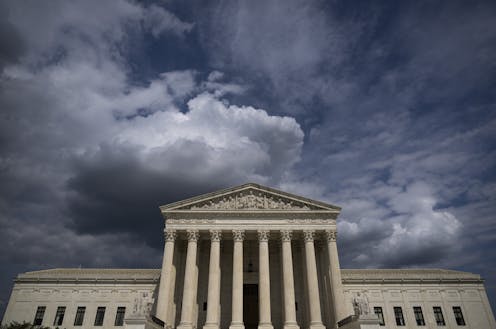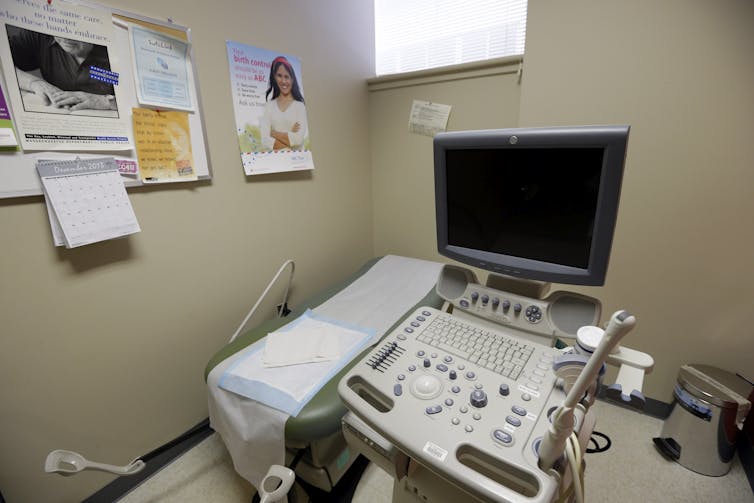Roe v. Wade gave American women a choice about having children – here's how that changed their lives
Over the past 48 years, women in the US have married later, attained higher education and joined the workforce in record numbers. Could a conservative Supreme Court turn it all back?

The U.S. Supreme Court will hear a case challenging a Mississippi state law that bans most abortions after 15 weeks of pregnancy, much earlier than the 24-week threshold generally established by the pivotal abortion rights case Roe v. Wade in 1973.
Roe v. Wade granted women the right to terminate a pregnancy under specific conditions, and subsequent court rulings have strengthened that precedent. Analysts on both sides of the abortion debate will be watching closely this fall to see whether the court’s new six-justice conservative majority – cemented last year in the waning days of the Trump administration – will weaken Roe v. Wade to restrict the abortion rights of Americans.
As a sociologist who studies women, work and families, I’ve closely examined how the landmark ruling affected women’s educational and occupational opportunities over the past half-century.
Then and now
Let’s go back to 1970, three years before the Roe decision.
In that year, the average age at first marriage for women in the U.S. was just under 21. Twenty-five percent of women high school graduates ages 18 to 24 were enrolled in college and about 8% of adult women had completed four years of college.
Childbearing was still closely tied to marriage. Those who conceived before marriage were likely to marry before the birth occurred. It wasn’t yet common for married women with young children under age 6 to be employed; about 37% of that group was in the labor force. Then, as now, finding satisfactory child care was a challenge for employed mothers.
By 1980, the average age at marriage had increased to 22. Thirty percent of American women ages 18 to 24 who had graduated from high school were enrolled in college, and 13.6% had completed a four-year college degree. Forty-five percent of married mothers with young children were in the labor force.
While these changes may not be directly attributable to Roe v. Wade, they occurred shortly after its passage – and they’ve continued unabated since then.
By 2020, roughly two generations after Roe v. Wade, women were further postponing marriage, marrying for the first time at age 28, according to the census. About 46% of all men and 41% of all women had never been married. Some estimates suggest a quarter of today’s young adults may never marry.
Moreover, the majority of college students are now women, and participation in the paid labor force has become an expected part of many women’s lives.
Control over choices
If the Roe v. Wade decision were overturned, women’s control over the timing and number of children they have would be reduced or even eradicated. Would the average age at first marriage, the educational attainment level and the labor force participation of women – and thus women’s overall socioeconomic status – decrease again?
These questions are difficult to answer. But we can see the effect that teen pregnancy, for example, has on a woman’s education. Thirty percent of all teenage girls who drop out of school cite pregnancy and parenthood as key reasons. Only 40% of teen mothers finish high school. Fewer than 2% finish college by age 30.
Educational achievement, in turn, affects the lifetime income of teen mothers. Two-thirds of families started by teens are poor, and nearly 1 in 4 will depend on welfare within three years of a child’s birth. Many children will not escape this cycle of poverty. Only about two-thirds of children born to teen mothers earn a high school diploma, compared with 81% of their peers with older parents.
New battles
Ongoing opposition to the legalization of abortion has succeeded in incrementally restricting U.S. women’s access to it.
Mississippi’s stringent abortion law, passed in 2018 but blocked by state courts, is one of several hundred laws enacted since 2011 by state legislatures that make abortions illegal after a certain point in early pregnancy.
Medical abortion isn’t the only way women can exert control over reproduction. Even before 1973 and Roe v. Wade, American women in some states had legal access to medical abortion, or pills that terminate a pregnancy, and to a wide range of contraceptives, including diaphragms and condoms – both longstanding devices – and the birth control pill, which came on the market in 1960.
However, some states restricted access to contraceptives. Five years after the pill was introduced, the Supreme Court ruled, in Griswold v. Connecticut, that married couples could not be denied access to contraceptives. In 1972, in Eisenstadt v. Baird, the court extended this right to unmarried persons.
After the Roe decision, annual abortions increased from 616,000 in 1973 to 1.4 million in 1990. But the number has been declining since then, reaching its lowest point in 2017 with 862,000 abortions. This is due in large part to an overall decline in pregnancies and births.
During the Trump administration, a record number of states acted to advance reproductive health rights by introducing legislation to protect abortion access. Several states, including New York, now guarantee a woman’s right to have an abortion within their borders.

Today, with the availability of a greater range of contraception, abortion drugs and state laws that protect abortion access, it seems unlikely that women’s status will ever go back to where it was before 1973, even if Roe v. Wade is struck down. For one, new state laws protecting abortion would stand. And the U.S. economy’s strong demand for women’s labor all but ensures women can’t be reconsigned into working primarily or exclusively in unpaid domestic roles.
But Roe v. Wade greatly improved the lives of generations of women across the U.S. in the last decades of the 20th century and early in the 21st, giving them previously unknown levels of freedom, autonomy and control over their lives.
This story is an updated version of an article originally published on July 5, 2018.
Constance Shehan does not work for, consult, own shares in or receive funding from any company or organization that would benefit from this article, and has disclosed no relevant affiliations beyond their academic appointment.
Read These Next
From record warming to rusting rivers, 2025 Arctic Report Card shows a region transforming faster th
The 20th anniversary of the annual report tracks how sea ice, snow cover and many other vital signs…
2 superpowers, 1 playbook: Why Chinese and US bureaucrats think and act alike
The men and women tasked with implementing policy are governed by the same incentives and constraints…
How rogue nations are capitalizing on gaps in crypto regulation to finance weapons programs
North Korea was behind a $1.5 billion digital bank heist in February 2025. Other countries are similarly…





